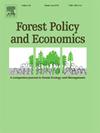优化美国西北太平洋地区的花旗松管理:整合木材价格、疏伐策略和采伐年龄决策
IF 3.8
2区 农林科学
Q1 ECONOMICS
引用次数: 0
摘要
在本研究中,建立了一个最优控制模型,以同时确定美国太平洋西北地区道格拉斯冷杉林的最佳间伐路径和采伐年龄,同时考虑各种间伐策略,随机木材价格和生产力条件。分析一般表明,在所有生产率水平和价格过程中,道格拉斯冷杉的最优减薄最多为两次。在随机木材价格下合并疏林,与未疏林的道格拉斯冷杉林相比,土地价值明显更高。例如,在固定的间伐率下,在独立和等分布(iid)价格下,低生产力水平和高生产力水平的土地价值分别增加25.1%(330.8美元/英亩)和59.7%(1375.9美元/英亩)。当间伐强度由内部决定时,土地价值在一阶自回归价格下分别上涨108.1%(1426.8美元/英亩)和91.2%(2102.8美元/英亩)。与iid过程相比,一阶自回归价格过程通常导致更高的土地价值。两种木材价格模型在相同的年龄下产生相同的薄化数;然而,在一阶自回归模型下,当变薄率是内因决定时,变薄强度较低。本文章由计算机程序翻译,如有差异,请以英文原文为准。
Optimizing Douglas-fir management in the U.S. Pacific northwest: Integrating timber prices, thinning strategies, and harvest age decisions
In this study, an optimal control model is developed to simultaneously determine the optimal thinning paths and harvest ages for Douglas-fir stands in the U.S Pacific Northwest, considering various thinning strategies, stochastic timber prices, and productivity conditions. The analysis generally indicates that a maximum of two thinnings is optimal for Douglas-fir across all productivity levels and price processes. Incorporating thinnings under stochastic timber prices results in significantly higher land values compared to unthinned Douglas-fir stands. For instance, with a fixed thinning rate, land values increase by 25.1 % ($330.8/acre) and 59.7 % ($1375.9/acre) under independent and identically distributed (iid) prices for low and high productivity levels, respectively. When thinning intensities are determined endogenously, land values rise by 108.1 % ($1426.8/acre) and 91.2 % ($2102.8/acre) with first-order autoregressive prices. The first-order autoregressive price process generally results in higher land values compared to the iid process. Both timber price models yield the same number of thinnings at the same ages; however, the thinning intensity is lower under the first-order autoregressive model when thinning rates are endogenously determined.
求助全文
通过发布文献求助,成功后即可免费获取论文全文。
去求助
来源期刊

Forest Policy and Economics
农林科学-林学
CiteScore
9.00
自引率
7.50%
发文量
148
审稿时长
21.9 weeks
期刊介绍:
Forest Policy and Economics is a leading scientific journal that publishes peer-reviewed policy and economics research relating to forests, forested landscapes, forest-related industries, and other forest-relevant land uses. It also welcomes contributions from other social sciences and humanities perspectives that make clear theoretical, conceptual and methodological contributions to the existing state-of-the-art literature on forests and related land use systems. These disciplines include, but are not limited to, sociology, anthropology, human geography, history, jurisprudence, planning, development studies, and psychology research on forests. Forest Policy and Economics is global in scope and publishes multiple article types of high scientific standard. Acceptance for publication is subject to a double-blind peer-review process.
 求助内容:
求助内容: 应助结果提醒方式:
应助结果提醒方式:


